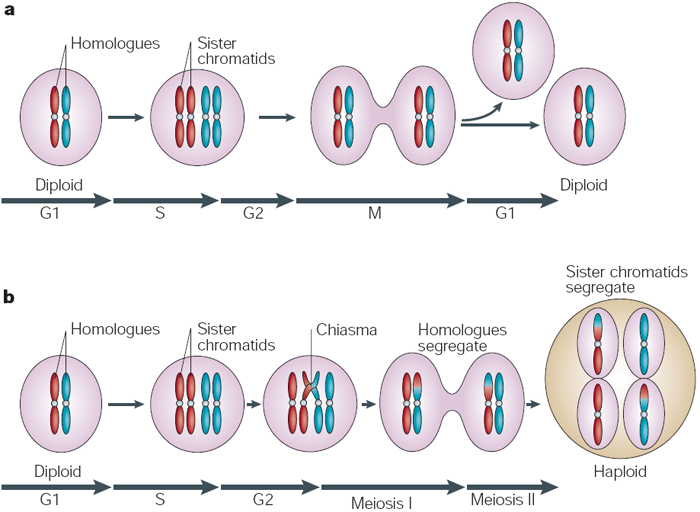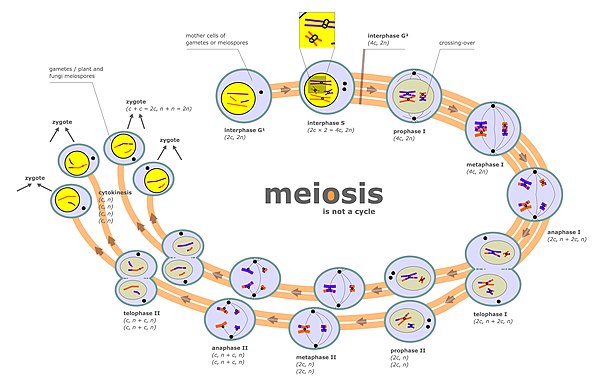The Segregation That Occurs During Meiosis Results in a
Reduction in the number of chromosomes per cellC. Of an allele pair the probability of each allele in a gamete is ½ or 50 percent.

The Mitotic And Meiotic Cell Cycles Learn Science At Scitable
The segregation that occurs during meiosis results in a -.

. Amon studied how the order of events of the cell cycle is established. In Meiosis II the individual chromatids may separate randomly to the spindle poles leading to a high incidence of aneuploidy. This allows sister chromatids to separate during anaphase of Meiosis I.
THIS DESCRIBES MENDELS LAW OF SEGREGATION Fertilization. Chromosome segregation is the process in eukaryotes by which two sister chromatids formed as a consequence of DNA replication or paired homologous chromosomes separate from each other and migrate to opposite poles of the nucleus. Independent assortment is the observation that the alleles of one gene segregate independently of the alleles of other genes.
In which phase of meiosis are the principles of segregation and independent assortment at work. Single fertilized egg cell. During anaphase I of meiosis the homologous chromosomes separate and are segregated to different cellsThis also segregates the homologous forms of a gene or alleles that are located on these.
Through meiosis germ cells produce gametes which contain only a single copy of the gene. Nondisjunction occurs when chromosomes fail to segregate during meiosis. This process results in each gamete usually containing a mixture of chromosomes from both original parents.
What is the result of segregation. In other words alleles segregate through the process of generating reproductive cells or meiosis. Decrease in total number of cells per organism.
Reduction in the number of chromosomes per cell. In her graduate work Dr. During Meiosis 1 Separase cleaves the majority of cohesin including that near the centromeres.
Independent assortment is the process where the chromosomes move. Genetic recombination is the process that introduces genetic diversity into the gametes during meiosis. Two cells have normal chromosomes and two cells have reciprocal translocations.
Decrease in the total number of cells per organism. Does independent assortment occur in meiosis 1 or 2. Probability predicts the recombination of alleles.
Segregation is the separation of alleles during the formation of gametes. However replication does occur during the interphase I stage of meiosis. The result is that each gamete carriers only one allele for each gene.
Interkinesis or interphase II is a period of rest that cells of some species enter during meiosis between meiosis I and meiosis II. Each DIPLOID germ cell has 2 COPIES of a gene. The translocation cross shown here which may occur in meiosis can result in three different segregation patterns.
The segregation that occurs during meiosis results in a. The result is 4 haploid daughter cells known as gametes. Match each segregation pattern with the correct description of the daughter cells.
During meiosis 1 diploid cell undergoes 2 cycles of cell division but only 1 round of DNA replication. The second stage at which segregation occurs during meiosis is prophase II. This segregation process occurs during both mitosis and meiosis.
Single fertilized egg cell. In her own lab she has characterized the mechanisms that govern accurate chromosome segregation during mitosis and meiosis including notably identifying the importance and regulation of the conserved phosphatase Cdc14 to mitotic exit. Segregation is the separation of the two alleles of every gene that occurs during meiosis.
When cells divide during meiosis homologous chromosomes are randomly distributed during anaphase I separating and segregating independently of each other. The diagram above shows the process of meiosis. Group of genetically identical cellsB.
This can occur in Anaphase 1 and Anaphase 2 and can lead to gametes with too many or too few chromosomes. Where does random segregation occur in meiosis. Decrease in the number of cells per organism.
The segregation that occurs during meiosis results in a--. This is called independent. Reduction in the number of chromosomes per cell.
The diagram above shows the process of meiosis. Two rounds of chromosome segregation and results in the formation of the gametes. This segregation process occurs during both mitosis and meiosis.
Group of genetically identical cells. What is the result of segregation. Improper chromosome segregation can result in aneuploid gametes having either too few or too many chromosomes.
The segregation that occurs during meiosis results in a A. When this happens gametes with an abnormal number of chromosomes are produced. Chromosome segregation is the process in eukaryotes by which two sister chromatids formed as a consequence of DNA replication or paired homologous chromosomes separate from each other and migrate to opposite poles of the nucleusThis segregation process occurs during both mitosis and meiosisChromosome segregation also occurs in prokaryotesHowever in.
No DNA replication occurs during interkinesis.

Meiosis Gene Segregation In Meiosis 2 Biology Resources Teaching Biology Biology Lessons In 2022 Biology Resources Teaching Biology Biology Lessons

Chromosome Segregation Wikipedia

4 Bp Blogspot Com V1 Shqnswbg Wd Ohkfvlmi Aaaaaaaacwq Gkezcv2dbpeyom7ffqbmr4koxxalophuaclcb S1600 Crossing 2bover Biology Notes Science Notes Biology Lessons
No comments for "The Segregation That Occurs During Meiosis Results in a"
Post a Comment